9 Best Knowledge Management Software Solutions in 2025

You have a wealth of knowledge stored in your organization, but is it a strategic asset or just a digital graveyard? A truly intelligent enterprise doesn’t just collect information. Instead, it puts information and data to work through a knowledge management (KM) system software.
In 2025, the market is overflowing with options, each promising to unlock your collective intelligence. To help you cut through the noise and find a solution that will turn your knowledge into a competitive advantage, we’ve reviewed the best knowledge management software solutions.
- Best KM software for enterprise: Bloomfire
- Best for small to mid-sized businesses: Guru
- Best for external knowledge use: Document 360
- Best for multichannel data distribution: Oracle
- Best for customization: Helpjuice
- Best for processing customer data: Market Logic
- Best for tech-savvy teams: Confluence
- Best for case management integration: Salesforce Knowledge
- Best for contact center operations: eGain
The right knowledge management software doesn’t simply store documents. It also connects people, powers smarter decisions, and transforms scattered data into a single, centralized source of truth. Read on to find out which KMS best suits your organization.
What Is Knowledge Management Software?
Knowledge management software is technology that allows you to capture, organize, find, share, and engage with your company’s knowledge. This may include explicit knowledge, such as product documentation or company policies, and tacit knowledge, like best practices a customer service manager has learned from years on the job. Knowledge may also be preserved in various formats, including text documents, slide decks, PDFs, videos, and more.
Most knowledge management software is cloud-based, meaning its users can access it from anywhere with an internet connection. Search, powered by artificial intelligence (AI) and machine learning, is also a core part of the knowledge management platform experience: users must be able to quickly navigate hundreds or thousands of knowledge assets to find the information they need.
Best Knowledge Management Software Solutions Overview
| Knowledge Management Platform | Pricing | Key Features | Rating (Out of 10) |
|---|---|---|---|
| Bloomfire | Custom quote to tailor to your needs | AI-powered search & discovery, Content categorization and tagging, Q&A functionality, Video transcription and indexing, Analytics suite | 9.1 |
| Guru | $15 to $18 per user/month; or custom pricing | Knowledge cards, Automated verification workflows, Seamless integrations, Browser extension | 8.4 |
| Document 360 | Custom quote | Knowledge base customization, AI-powered search, Version control, Analytics | 7.7 |
| Oracle | Custom quote | Seamless integration with other native systems, Unified self-service, AI-powered search, Content authoring and workflow | 7.3 |
| Helpjuice | Ranges from $120/month (4 users max) to $659/month (unlimited users) | Extensive customization, Comprehensive analytics, Collaboration tools, Excellent customer support | 7.2 |
| Market Logic | Custom quote | AI-powered insights and search, Centralized knowledge repository, Strong administrative and security features, Effective content management and collaboration | 7.1 |
| Confluence | Ranges from $5.16 per user/month to custom price | Integration with Jira and other Atlassian products, Real-time collaborative editing, Structured hierarchy with Spaces and Pages, Extensive template library, Customization through the Atlassian Marketplace | 6.9 |
| Salesforce Knowledge | Included in Service Cloud subscription | Integration with Salesforce Service Cloud:, Case deflection and self-service, Content management and version control, Targeted content and access control, Analytics and feedback | 6.9 |
| eGain | Custom quote | Omnichannel engagement, Guided assistance and self-service, Robust analytics and reporting, Integrations with other systems | 6.8 |
1. Bloomfire: Best Knowledge Management Software for Enterprise

Bloomfire is an enterprise knowledge management platform that transforms scattered information into a dynamic, centralized hub of intelligence. The platform’s AI-driven search capabilities, automated content curation, and seamless integrations with existing workflows ensure that employees can find trusted information right when they need it.
Who is Bloomfire for?
Bloomfire is an ideal cloud-based knowledge management platform for any organization that wants to transform its internal knowledge into a strategic asset–primarily through advanced tools and AI integration. It is mainly designed for enterprises, large-scale organizations, and mid-market companies.
The platform is also highly beneficial to teams that rely on quick, accurate access to information to perform their jobs effectively, making it one of the most trusted internal knowledge management software for employees. This includes customer service departments that need to resolve inquiries quickly, sales and marketing teams that require current product knowledge and market intelligence, and research and insights teams that must share data-driven findings.
With Bloomfire, these teams don’t just manage knowledge—they activate it—laying the foundation for Enterprise Intelligence, where knowledge flows freely across departments and drives faster, smarter decisions at scale.
Bloomfire Pros and Cons
| Pros | Cons |
|---|---|
|
|
| Explore Bloomfire | |
Bloomfire has earned its reputation as a leading AI knowledge management solution for enterprises by excelling where many of its competitors fall short: a focus on making knowledge dynamic and actionable.
A key part of this is its advanced AI and semantic search, which goes far beyond simple keyword matching to understand the context and intent of a user’s query. This attribute is crucial for large organizations with large amounts of information, as it ensures that employees can find the exact piece of knowledge they need, whether it is buried in a PDF, a video transcription, or an article.
The platform’s strong integrations with other business platforms and intuitive interface further facilitate this process, allowing knowledge to be used as a strategic asset rather than a static repository. This is why Bloomfire is used to augment platforms like SharePoint–specifically to address its known disadvantages.
While SharePoint excels at storing and managing documents, Bloomfire adds the intelligent layer that transforms static content into dynamic knowledge. By applying the guiding principles of Enterprise Intelligence, such as connecting knowledge pools, enabling a self-healing knowledge base, and surfacing insights in the flow of work, Bloomfire transforms a traditional repository into a living, searchable, and collaborative hub. The result: knowledge that’s not just accessible, but actionable.
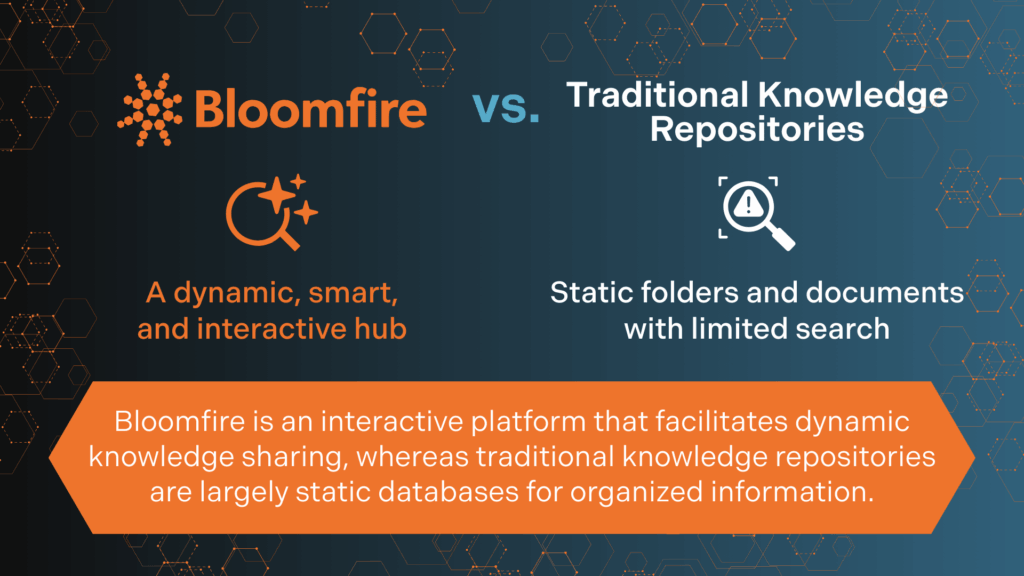
Bloomfire’s position as an enterprise-grade solution comes with its own set of trade-offs. The platform’s high level of functionality and social features are most impactful for larger teams that can generate and benefit from a continuous flow of content. Smaller organizations may find the extensive features and pricing to be overkill.
Also, the platform’s ability to deliver optimal results is highly dependent on effective content curation. Without a dedicated effort to ensure content is tagged correctly, verified, and kept up to date, even the most advanced and best customer service knowledge management systems will fail to deliver value.
Bloomfire Pricing
Bloomfire’s pricing is customized based on the scope and size of an organization’s knowledge program, not a per-user fee. You can expect flexible plans tailored to the specific needs of your team, department, or entire enterprise. For more details, talk to a knowledge management expert from Bloomfire.
Expert Insights on Bloomfire Features
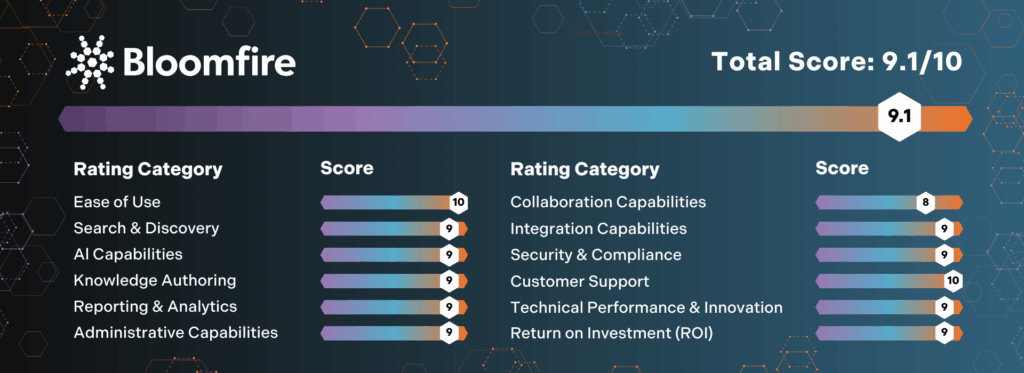
In his expert analysis, Dr. Anthony J. Rhem highlights Bloomfire as a leading provider of AI knowledge management tools, distinguished by its user-friendly interface and sophisticated AI-driven capabilities. Its robust search and discovery mechanisms, enhanced by AI and semantic technologies, ensure precise information retrieval. Meanwhile, its generative AI “Ask AI” feature provides direct, contextually relevant answers.
The platform’s strong scores in knowledge authoring, reporting analytics, and administration reflect its comprehensive functionality for content creation, data-driven decision-making, and effective content management.
Here are some of the standout features of Bloomfire:
- AI-powered search: Instantly finds relevant answers by deep-indexing content, including videos and PDFs
- Content categorization and tagging: Organizes knowledge with customizable categories to make information easier to find
- Q&A functionality: Allows employees to ask questions and stores the answers for future reference in its internal search engine
- Video transcription and indexing: Automatically transcribes and indexes video content to make it searchable
- Analytics suite: Provides insights into user engagement and identifies knowledge gaps for improvement
Bloomfire takes pride in its advanced features. Additionally, the platform is recognized for its intuitive interface. Experts note that this ease of use helps drive adoption, making it simple for all employees, regardless of their technical skills, to contribute and access knowledge.
Bloomfire is also recognized for its Enterprise Intelligence value approach, which positions the platform not just as a repository, but as a strategic tool for leveraging knowledge to drive business growth, innovation, and measurable return on investment (ROI).
2. Guru: Best for Small to Mid-Sized Businesses
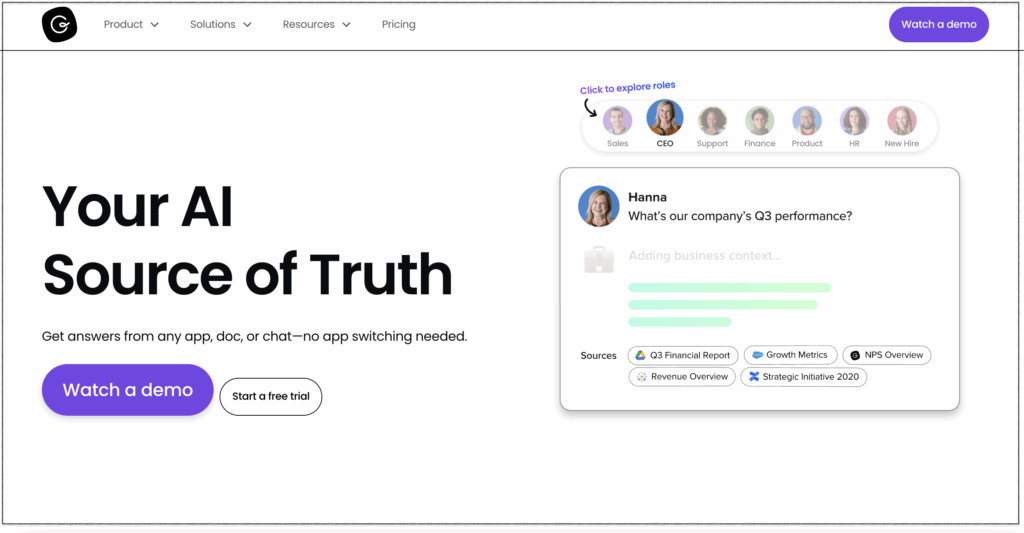
Guru is a knowledge management platform that centralizes and streamlines information flow within organizations. It is often considered an ideal software for teams that need verified information to improve efficiency and customer satisfaction. However, large enterprise organizations usually require dynamic search functionality to navigate vast amounts of knowledge.
Who is Guru for?
Guru is a knowledge management solution ideal for mid-sized businesses, particularly those with a distributed or fast-growing team. Its strength lies in its ability to integrate directly into existing workflows through browser extensions and your collaboration platform.
Guru’s focus on cards and a verification system ensures that information is accurate and easily digestible. This approach enables mid-sized companies to maintain a single source of truth as they scale, thereby preventing the creation of information silos that can hinder growth and productivity.
Guru Pros and Cons
| Pros | Cons |
|---|---|
|
|
| Learn More | |
Guru’s focus on providing a user-friendly experience that integrates into existing workflows makes it a suitable solution for mid-sized businesses. Its intuitive interface and a card-based system for knowledge simplify the process of documenting and sharing information.
The platform’s integrations with popular tools, such as Slack and Microsoft Teams, are also major advantages. These features enable teams to access accurate information instantly, eliminating the need to switch applications and thereby boosting productivity and reducing repetitive questions.
While Guru’s initial setup is simple, users report that as the volume of content grows, it becomes challenging to maintain organization. It requires significant manual upkeep, including constant content verification, which can become a full-time job for a team member in a rapidly expanding company. This reliance on human management can lead to a messy knowledge base with outdated information if a dedicated knowledge manager is not in place.
Additionally, the platform’s limited customization and formatting options, while making it easy to use, can be a point of friction for teams that need to create more detailed or structured documents. Thus, it can create scalability issues as an organization and its knowledge base grow — a feat addressed by its competitors, which are designed for an enterprise environment, such as Bloomfire.
Guru Pricing
Guru offers a straightforward, per-user, per-month pricing model designed to scale with your team’s needs. The core of their offering is the All-in-One plan, which includes their AI-powered search, intranet, and wiki features. For larger organizations, an Enterprise plan is available with custom pricing, offering advanced features such as dedicated support, enhanced security, and custom integrations.
- All-in-One Plan: $15 per user/month (billed annually) or $18 per user/month (billed monthly).
- Enterprise Plan: Custom pricing for large organizations with specific needs.
While Guru does not offer a free version, a 30-day free trial provides full platform access, allowing users to test its capabilities before committing to a paid plan.
Expert Insights on Guru Features
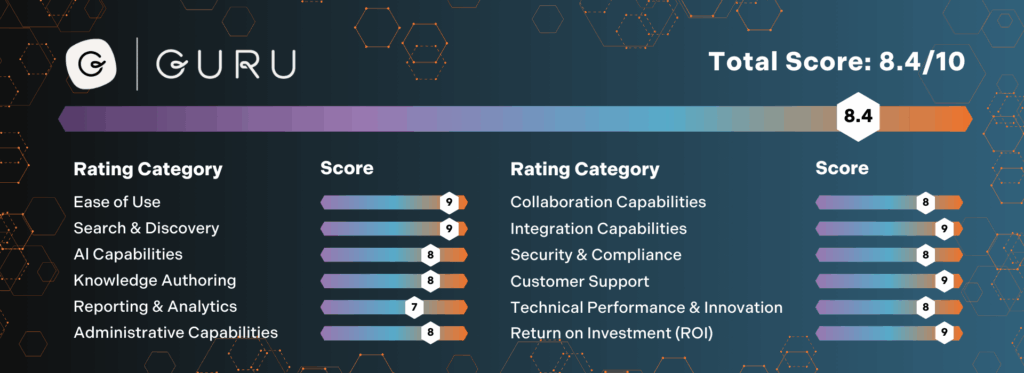
We found that Guru’s knowledge management software is well-suited for mid-sized businesses, despite often being considered a top choice for enterprise knowledge management software for small businesses. The platform’s high marks for ease of use and its powerful AI-driven search capabilities ensure that employees can quickly find the information or data they need, which is crucial as content begins to scale.
Guru’s key features for knowledge management include:
- Knowledge cards: Organize information into bite-sized, digestible formats called cards
- Automated verification workflows: Ensures the accuracy and trustworthiness of information
- Seamless integrations: Connects with popular workplace applications like Salesforce, Slack, and Microsoft Teams
- Browser extension: Delivers information directly within the user’s workflow, eliminating the need to switch between apps to find answers
While it lacks some advanced document management features, its robust collaboration and integration capabilities with workplace tools enable seamless workflow connections. Bloomfire, on the other hand, can be a great option if your priority features are advanced document management due to its dynamic, searchable, and collaborative knowledge hub.
3. Document 360: Best for External Knowledge Use
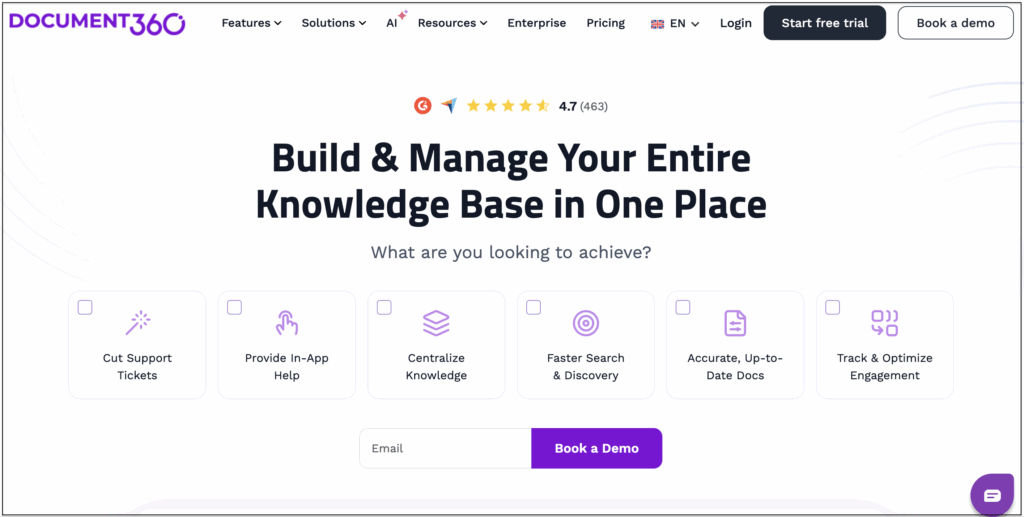
Document360 is designed for creating, managing, and publishing knowledge for internal use and customer-facing public help centers. It allows organizations to manage a single repository of content while dynamically publishing different versions or subsets of that content to distinct user groups.
Who is Document 360 for?
Businesses that prioritize building a structured, scalable, and professional customer-facing knowledge base may find Document360 as a suitable solution. It offers customer-focused features, such as storage for detailed, searchable documentation, FAQs, and user guides, that help reduce support tickets and improve customer satisfaction.
Document 360 Pros and Cons
Through its robust administrative features, Document 360 provides a high degree of control over who can create, edit, and publish content. The version control system ensures the integrity of the information, which is paramount for an accurate and trustworthy customer help center.
Combined with high marks for security and compliance, the platform allows businesses to house their official product documentation and support materials. This focus on a structured, professional, and secure knowledge base makes Document 360 a contender among KM solutions that provide a dependable, public-facing resource.
However, Document360’s specialization for this use case also introduces some notable limitations. The platform’s more structured approach means it has limited real-time collaboration features, which can slow down content creation for teams used to simultaneously editing documents in other applications.
It is built to house information, but its integrations with external content sources are not always comprehensive. Additionally, while the end product is user-friendly for customers, setting up the knowledge base can be a challenge for administrators initially. The process of organizing content into a logical structure with categories and subcategories requires significant upfront work.
Document 360 Pricing
Document 360 offers plans based on a per-project, per-month model, with costs increasing for more advanced features, higher storage limits, and a greater number of team accounts. Potential customers can request a demo or contact their sales team for a customized quote, indicating that pricing may vary based on individual needs and the number of users.
- Startup: An entry-level paid plan for small teams, often with a set number of team accounts
- Business: A mid-tier plan for growing teams, which includes more features and a higher number of user accounts
- Enterprise: A custom-priced plan for large organizations requiring tailored features, unlimited articles, and dedicated support
The plans are differentiated by the number of team accounts, articles, storage, and access to more advanced features, such as private documentation and robust analytics.
Expert Insights on Document 360 Features
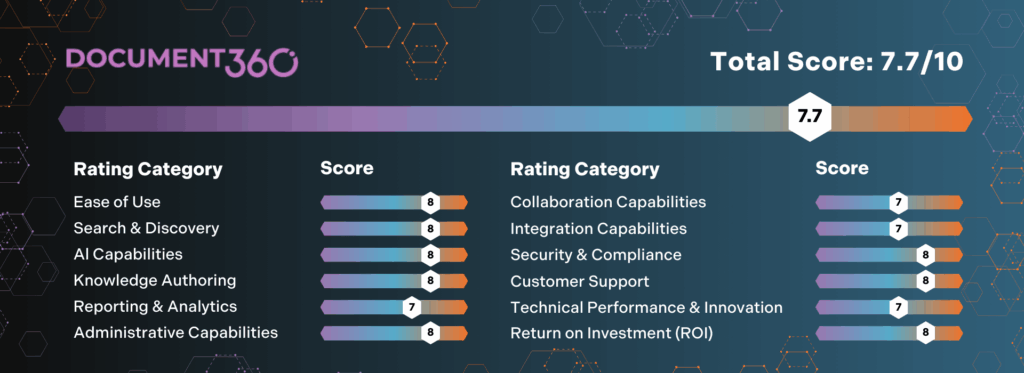
Document 360 excels in areas vital for customer-facing solutions, particularly its ease of use and powerful knowledge authoring tools, which enable both technical and non-technical users to create and manage content efficiently.
Standout features of Document 360:
- Knowledge base customization: Extensive options to customize the knowledge base’s appearance to match brand identity, including layouts, colors, and fonts
- AI-powered search: Understands user intent to deliver accurate, relevant results, and offers features like AI-powered content creation assistance
- Version control: Robust versioning tools that allow for side-by-side comparison of different versions of a document, ensuring content integrity and easy rollbacks
- Analytics: Provides real-time insights into user behavior, content effectiveness, and engagement patterns to help with data-driven decisions and content strategy
We found that the platform’s strong administrative, security, and compliance capabilities provide a reliable framework for content governance and data protection. While there are areas for improvement, particularly in real-time collaboration and the development of a dedicated mobile app, the platform’s overall strengths make it a viable option in its domain.
4. Oracle: Best for Multichannel Data Distribution
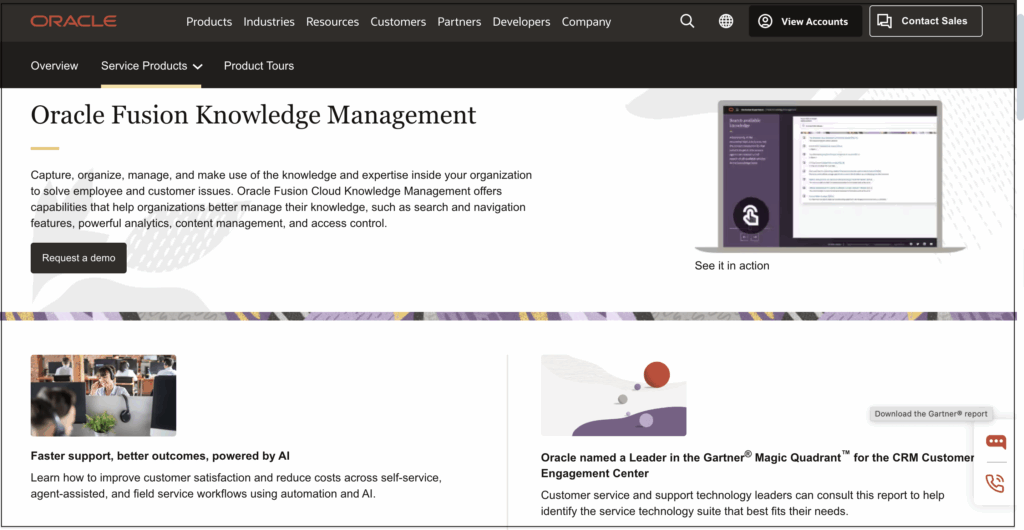
Oracle provides knowledge management as a core component of its broader enterprise offering, as opposed to a standalone knowledge base. It is deeply integrated into its larger ecosystem of business applications, particularly within the Oracle Fusion Cloud and CX (Customer Experience) suite.
Who is Oracle for?
Oracle’s knowledge management solution targets large, complex enterprises that require a robust system for distributing multichannel data. It also appeals to organizations already integrated into the Oracle ecosystem.
Oracle Pros and Cons
Oracle’s seamless integration with other Oracle products is a significant pro, as it allows organizations to create an end-to-end ecosystem. Users benefit from effortless data flow from a CRM or ERP system to a knowledge management system and out to various customer-facing channels.
The platform’s high technical performance and reliability are also crucial, as they enable it to handle the immense data volumes required for a global, multichannel strategy, ensuring a smooth and consistent user experience even under heavy loads.
A notable drawback of using Oracle is its steep learning curve for users. Furthermore, the higher total cost of ownership (TCO) is a common criticism, as it encompasses not only licensing fees but also substantial expenses for implementation, customization, and ongoing maintenance.
The less intuitive interface, especially for users unfamiliar with the Oracle ecosystem, also contributes to its reputation as a powerful but often rigid and difficult-to-master solution. While Oracle is a powerhouse for large-scale, complex data distribution, it may require a substantial investment in capital, expertise, and time.
Oracle Pricing
Oracle Knowledge Management’s pricing is part of a broader suite of enterprise solutions, and as such, it does not have a simple, publicly available price list. Pricing is customized for each client based on their specific needs, including the number of users, required modules, and contract length.
Expert Insights on Oracle Features
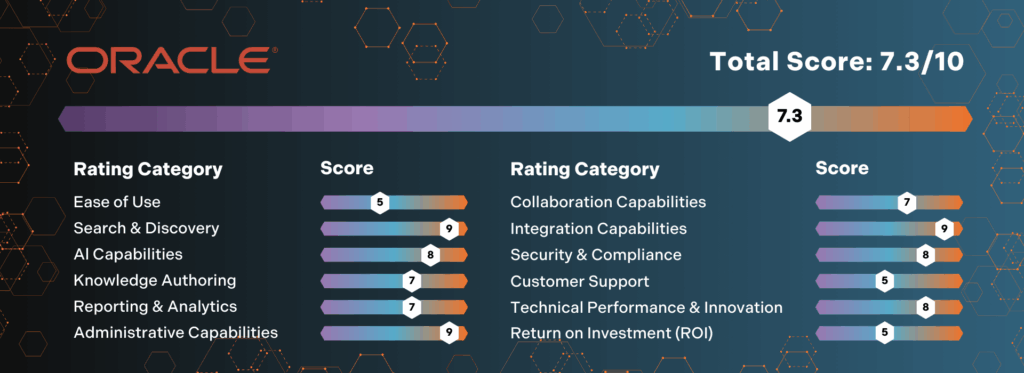
Oracle Knowledge Management is a powerful tool for organizations already operating within the broader Oracle ecosystem. We find that the platform’s strength lies in its ability to integrate with other Oracle applications, which we believe makes it a prime choice for organizations focused on multichannel data distribution.
However, we also recognize the platform’s complexities. Knowledge authoring and administration capabilities present challenges that necessitate significant training and specialized resources.
Oracle’s renowned KM features:
- Seamless integration with other native systems: Integrates with other Oracle applications, such as CRM and service platforms, to provide a consistent and unified experience for both agents and customers
- Unified self-service: Delivers consistent information across all channels, allowing customers to find answers independently and empowering agents to resolve complex issues
- AI-powered search: Uses machine learning and natural language processing (NLP) to understand search queries and provide the most relevant answers
- Content authoring and workflow: Provides an intuitive, rich media editor and customizable templates for creating knowledge articles
Despite the usability concerns and the substantial total cost of ownership, its scalable technical performance and integrations make it a strong solution for enterprises seeking a deeply integrated knowledge management system.
Overall, it is a suitable choice for Oracle-centric teams that can invest in the necessary support and strategic planning to maximize its potential.
5. Helpjuice: Best for Customization
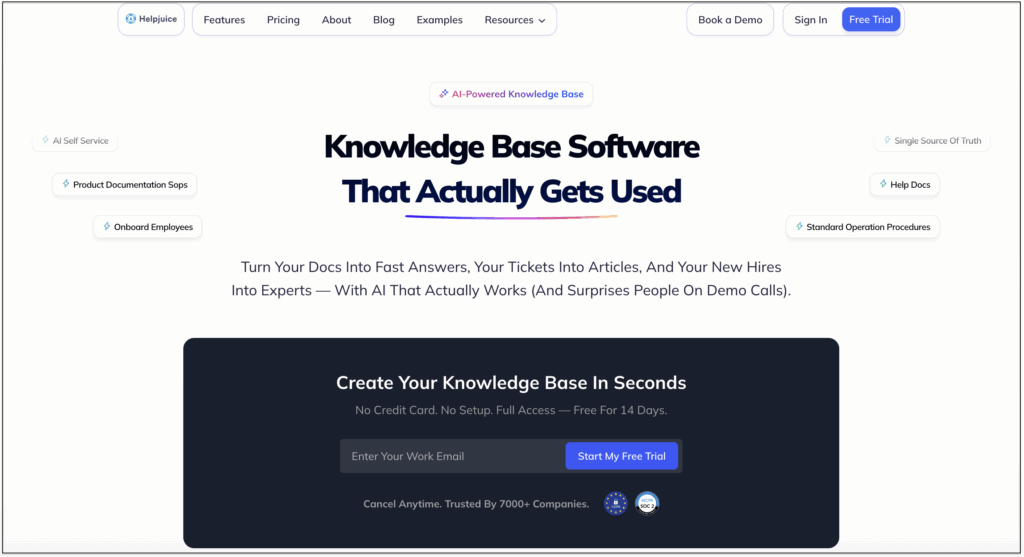
Helpjuice offers knowledge management software with a customizable and user-friendly knowledge base, with a particular emphasis on customer support and self-service. The company is primarily known for its powerful, Google-like search functionality that makes it easy to find information quickly.
Who is Helpjuice for?
If you’re a business that prioritizes a high degree of customization and brand control over your knowledge base, Helpjuice can be a good option. This focus on tailored design makes it particularly well-suited for mid-sized companies seeking to establish a professional, polished knowledge base for both internal and external use, without requiring extensive in-house development resources.
Helpjuice Pros and Cons
With its robust customization options, Helpjuice lets businesses align the look and feel of their knowledge base with their brand identity. This level of control is a major draw for companies seeking to provide a polished, professional self-service experience to their customers.
Additionally, the platform’s detailed reporting and analytics provide businesses with in-depth insights into how their content is performing. This allows them to make data-driven decisions to improve their articles and user experience.
While its key features show promise in brand alignment, the extensive customization can be a double-edged sword for non-technical users. Without a background in coding, it can be challenging to fully leverage the platform’s potential, and some users may require additional assistance or resources to achieve their desired design.
Moreover, while Helpjuice excels at creating a public-facing knowledge base, it falls short in collaborative features, lacking real-time editing and more basic internal content creation tools compared to its competitors. The platform’s limited AI capabilities and lack of granular metadata alteration are also notable drawbacks, as they can hinder content optimization and searchability, especially in an increasingly AI-driven market.
Helpjuice Pricing
Helpjuice’s pricing is structured around the number of users, with different tiers offering access to an increasing number of team members and features. This allows businesses to select a plan that suits their current team size, while providing a clear path for future scaling.
- Starter: Starts at $120 per month for up to 4 users
- Run-Up: Starts at $200 per month for up to 16 users
- Premium Limited: Starts at $289 per month for up to 60 users
- Premium Unlimited: Starts at $659 per month for an unlimited number of users
All plans include core features like powerful search, unlimited articles, and a 14-day free trial. The main differentiator between the plans is the user count, with higher tiers also providing access to more advanced features such as enhanced analytics and free expert customization.
Expert Insights on Helpjuice Features
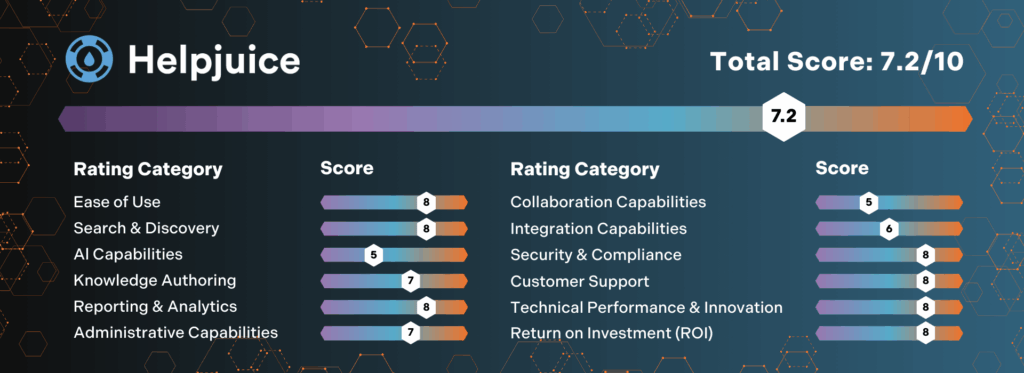
Our assessment confirms that a key strength of Helpuice is its focus on ROI and cost efficiency, which directly supports a client’s ability to tailor the platform to their specific needs without incurring excessive expenditure.
Standout features of Helpjuice:
- Extensive customization: Ability to be fully customized to match a company’s brand, from layouts and fonts to overall design
- Comprehensive analytics: Provides in-depth insights into user behavior, including which articles are most popular and what users are searching for
- Collaboration tools: With robust collaboration tools like version control, that simplify content creation and management for teams
- Excellent customer support: Responsive and helpful customer support team, assisting with customization and quick problem resolution
The platform’s robust reporting and straightforward content authoring capabilities provide a strong foundation. This allows for significant customization in how content is managed and delivered.
6. Market Logic: Best for Processing Customer Data

Market Logic is an enterprise-grade knowledge management provider with a strong reputation for its specialization in market and consumer insights. It is best suited for a specific audience of market researchers and brand managers, and while powerful for its niche, it is not a general-purpose knowledge management tool.
Who is Market Logic for?
Market Logic is tailored for global consumer-facing companies that heavily rely on customer data. It particularly targets those in consumer packaged goods (CPG), healthcare, and retail that require a customized platform to manage market research and consumer insights.
Market Logic Pros and Cons
Market Logic’s user-friendly interface centralizes and organizes diverse data sources, including market research reports, social media listening, and internal studies. Also, the comprehensive analytics and reporting features not only locate information but also understand its implications and communicate it effectively to stakeholders.
Although Market Logic’s value in delivering actionable insights is solidified, its reputation is not without its caveats. The user interface may be intuitive for consumption, but achieving the platform’s full potential requires a deep understanding of information architecture to properly structure and organize the data. This means that for a company to get the most out of the system, the initial setup and implementation can be complex and time-consuming.
Furthermore, experts and users alike highlight its weakness in its integration and security features, which may not always align with the rigorous standards of every industry. This creates a potential challenge for large enterprises in highly regulated sectors that require the highest level of data security and seamless integration with their existing tech stack.
Did You Know?
Data collection is just the tip of the iceberg of knowledge creation. Customer data is only valuable when converted into actionable insights and knowledge that inform decision-making and drive internal system improvements. This is where Bloomfire becomes an ideal choice for organizations, as it ensures your knowledge becomes part of a wider Enterprise Intelligence engine.
Market Logic Pricing
Market Logic’s pricing is not publicly disclosed on its primary website, a common practice among enterprise-level software vendors. Instead of fixed plans, they offer a flexible and scalable pricing model tailored to the specific needs of each business.
Expert Insights on Market Logic Features
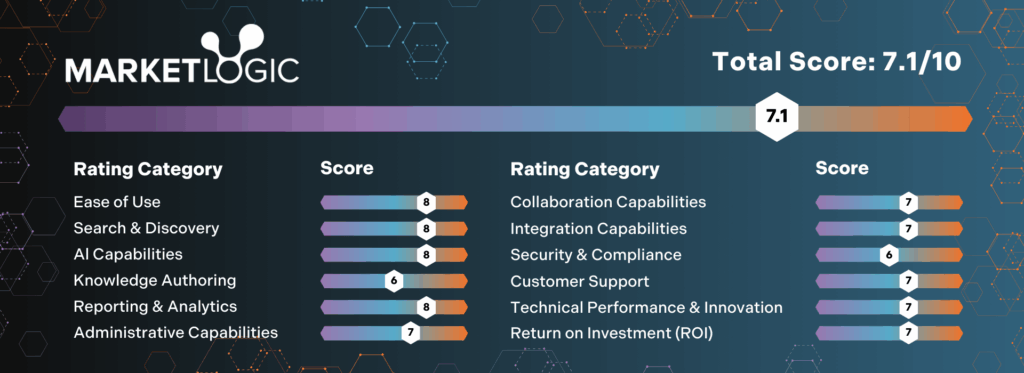
In the detailed assessment by Anthony J. Rhem, Ph.D., and our team, we found Market Logic to be a firm option for organizations that need to process and leverage customer data effectively. The platform’s core strengths lie in its ability to serve as a central hub for market research and consumer insights.
Market Logic’s notable knowledge management features:
- AI-powered insights and search: Uses advanced AI to analyze and synthesize market research, competitive intelligence, and other data sources
- Centralized knowledge repository: A single, intuitive platform to store, organize, and access market intelligence, eliminating data silos and outdated information
- Strong administrative and security features: Provides robust access controls and data governance
- Effective content management and collaboration: Includes tools for experts to curate, publish, and share market insights
The robust reporting and analytics features are invaluable for tracking knowledge usage, identifying crucial insights, and driving strategic decisions. This functionality, which tracks and analyzes knowledge, is why the platform excels at turning raw consumer data into actionable intelligence. While we commend the platform’s user-friendly interface and responsive support, we noted some limitations in customization and content creation.
7. Confluence: Best for Tech-Savvy Teams
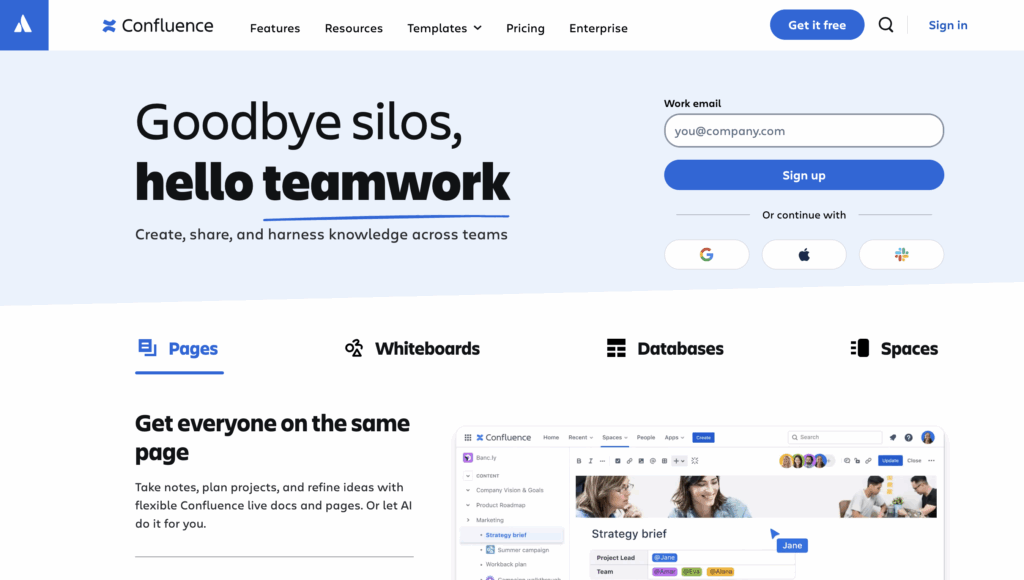
Confluence, from Atlassian, holds a strong reputation in the market as a collaborative workspace that doubles as software for knowledge management. It is widely recognized for its robust integration with the broader Atlassian suite, particularly Jira, allowing software development and IT teams to create, organize, and share documents.
Who is Confluence for?
Confluence is an ideal collaborative knowledge management software for tech-savvy teams, particularly those in software development, IT, and engineering, that are already embedded in the Atlassian ecosystem. Due to its flexibility, it benefits teams that are comfortable with a more hands-on setup and want to link project management directly to documentation, rather than for a business seeking a simple, plug-and-play solution for general company-wide use.
Confluence Pros and Cons
If your organization is already using Jira, you might be interested to know that Confluence’s direct connection with the app is probably its most powerful asset. This synergy allows software development teams to link documentation, project plans, and product requirements directly to issue tickets, creating a single source of truth and a highly efficient workflow.
Additionally, the platform’s user-friendly interface, complete with a wide range of templates, makes it easy for teams to get started on everything from project plans to technical specifications.
However, these strengths are undermined by significant drawbacks that can impact productivity as teams grow. A key issue is its limited search and discovery capabilities.
While Confluence is a powerful tool for creating documentation, many users report that its search function can be clunky and ineffective, making it difficult to find specific information within a large knowledge base. This problem is compounded by poor metadata management, which makes it challenging to organize and categorize content effectively.
Moreover, while the platform supports attachments, its handling of external files is often cited as a weakness. For tech teams that rely on a wide range of file types and need to access information quickly, these limitations can significantly hinder efficiency.
Confluence Pricing
Confluence offers a tiered pricing model designed to accommodate teams of all sizes. For growing teams, the paid plans are based on a per-user, per-month subscription. As the number of users increases, the cost per user decreases, allowing the platform to scale affordably with an organization.
- Free: For up to 10 users, and provides a limited set of core features
- Standard: Starting at $5.16 per user/month; for teams that need more users, storage (250 GB), and additional features like space permissions
- Premium: Starting at $9.73 per user/month; includes advanced features like unlimited storage, advanced admin controls and analytics, and a higher level of support
- Enterprise: Custom-priced plan for large organizations that need a tailored solution
The pricing for larger-scale plans is often handled through custom quotes. This is primarily targeted to organizations that require advanced security, dedicated support, and the ability to manage multiple sites.
Expert Insights on Confluence Features
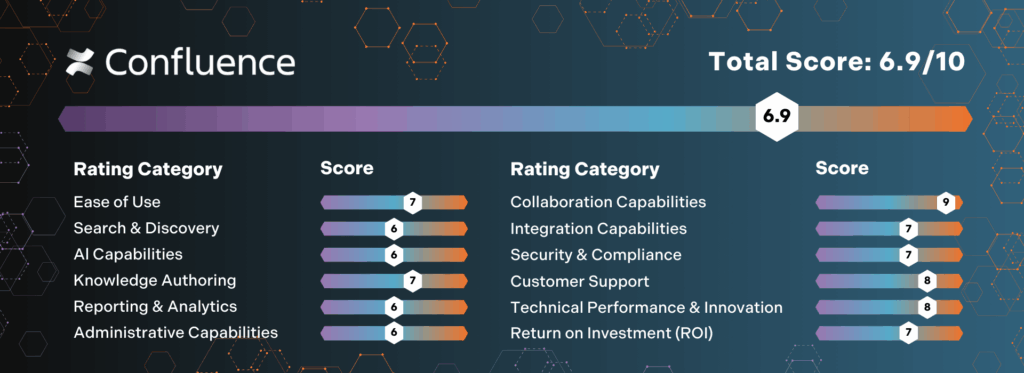
Upon using Confluence, we discovered the platform’s robust collaboration features, which facilitate real-time project execution and knowledge sharing, particularly when integrated with other Atlassian products, such as Jira. This, along with a user-friendly interface and seamless integrations with various business tools, makes Confluence a go-to workspace for agile teams.
Key KM features of Confluence:
- Seamless integration with Jira and other Atlassian products: Allows development and IT teams to link documentation directly to project tasks, issues, and sprints
- Real-time collaborative editing: Multiple users can simultaneously edit the same page.
- Structured hierarchy with Spaces and Pages: Provides a clear way to organize information, making it scalable for different teams and projects
- Extensive template library: Offers a wide range of pre-built templates for standard documents like project plans, meeting notes, and knowledge base articles
- Customization through the Atlassian Marketplace: A massive library of add-ons and apps allows teams to extend and tailor Confluence’s functionality to their specific needs
However, it was noted that its limitations include delivering enterprise-wide, scalable knowledge. The search functionality, for instance, primarily relies on keywords, and its AI capabilities are not yet sophisticated enough for non-technical users. This is a common point of feedback from users who find that as their knowledge base expands, content becomes increasingly difficult to locate.
8. Salesforce Knowledge: Best for Case Management Integration
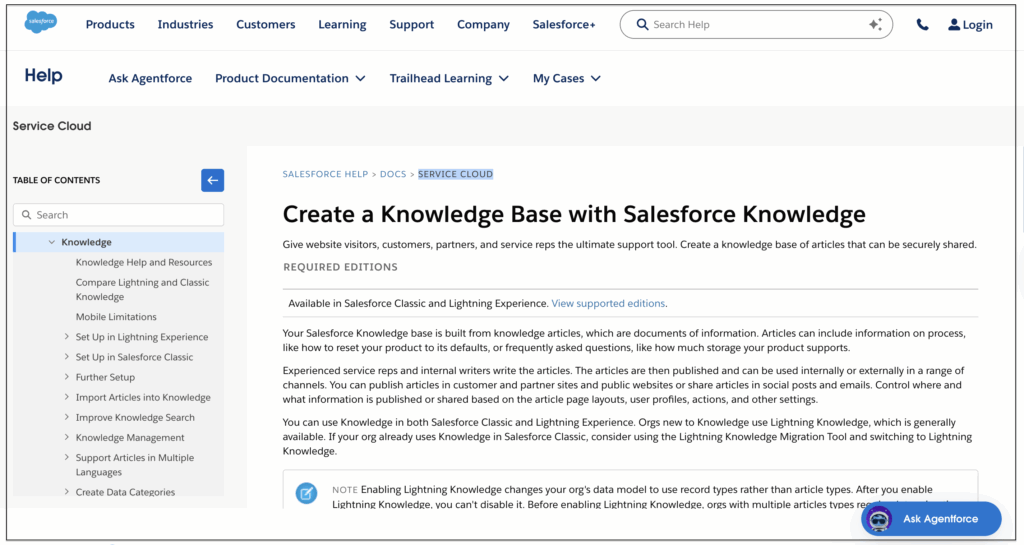
Salesforce Knowledge is a knowledge management solution deeply integrated into the Salesforce ecosystem, primarily within its Service Cloud. The system is renowned for its seamless ability to connect knowledge articles directly to cases, serving as a centralized repository for articles that both service agents and customers can use for self-service — a key driver of agent efficiency and case deflection.
Who is Salesforce Knowledge for?
If your organization is already operating within the Salesforce ecosystem, Salesforce Knowledge is primarily for you. It is especially beneficial for those who have a heavy focus on customer support and case management. The platform’s robust security features, alongside intelligent search and discovery enhancements powered by Einstein AI, provide a highly reliable and efficient solution for customer service and self-help applications.
In our assessment, we confirmed a significant learning curve, customization, and some investment to unlock its full potential. Nonetheless, its ability to empower service agents and deflect cases by providing customers with self-service options makes it appealing for organizations focused on optimizing their case management workflows.
Salesforce Knowledge Pros and Cons
Salesforce Knowledge is designed to work seamlessly with Salesforce’s Service Cloud, allowing customer service agents to access and use knowledge base articles directly within the case management interface. This streamlined workflow dramatically reduces the time it takes for agents to find answers and resolve customer issues.
The use of Salesforce’s Einstein AI further enhances this reputation by providing smart, contextual recommendations. Agents can proactively surface the most relevant articles for a given case, leading to quicker resolutions and a better customer experience.
However, the very strengths that make Salesforce Knowledge so effective are also tied to its key drawbacks. Its technical complexity is a significant hurdle. Managing and maintaining the platform requires specialized administrators or consultants with a deep understanding of the Salesforce ecosystem. This complexity is compounded by a high total cost of ownership, which goes beyond just licensing fees.
Customization, while a powerful feature, often requires professional services or skilled in-house developers, contributing to high implementation costs. The platform’s native content creation capabilities are also limited, with users reporting that it struggles with diverse content formats, which may force organizations to rely on external content creation tools and a more complex content lifecycle.
That said, Salesforce Knowledge is an unparalleled solution for organizations fully invested in the Salesforce ecosystem. However, its steep learning curve and high costs make it a less viable option for businesses that lack the technical resources or budget to support it.
Salesforce Knowledge Pricing
Salesforce Knowledge’s pricing is tied directly to its Service Cloud platform, and it is not typically sold as a standalone product. It is included in every Salesforce Service Edition, which means its cost is baked into the overall per-user, per-month price of the Service Cloud subscription.
Expert Insights on Salesforce Knowledge Features
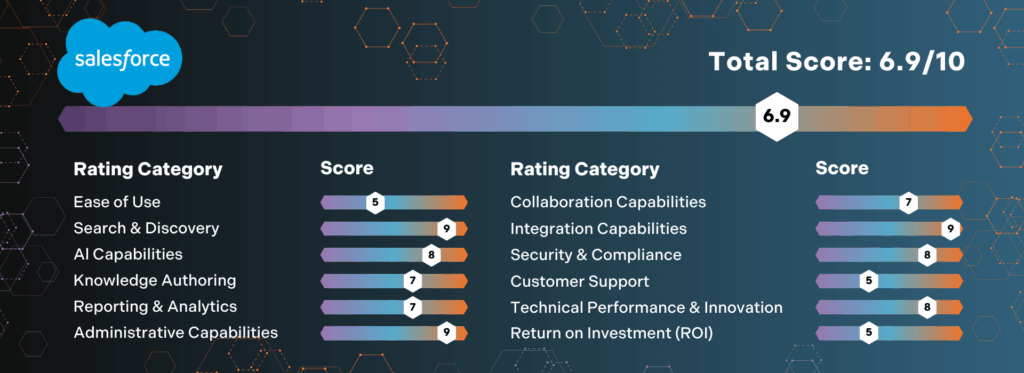
Salesforce has strong native integration capabilities, deeply integrated into the Salesforce ecosystem, which facilitate seamless access to and management of knowledge directly within the platform’s case management tools.
Salesforce Knowledge known KM features:
- Integration with Salesforce Service Cloud: Embeds directly into the Service Console, allowing support agents to access and attach relevant articles to cases without leaving their workflow
- Case deflection and self-service: Provides a robust, searchable knowledge base for customers
- Content management and version control: Offers a structured process for creating, editing, and publishing articles with built-in versioning, ensuring content accuracy and consistency
- Targeted content and access control: Uses a system of data categories and user permissions to control who can view and access specific articles
- Analytics and feedback: Includes reporting tools to track article usage, ratings, and search effectiveness
Salesforce Knowledge excels in providing a unified, centralized, and customizable knowledge base that directly integrates with the Salesforce CRM. This enables easy case deflection and provides a single source of truth for agents and customers.
9. eGain: Best for Contact Center Operations
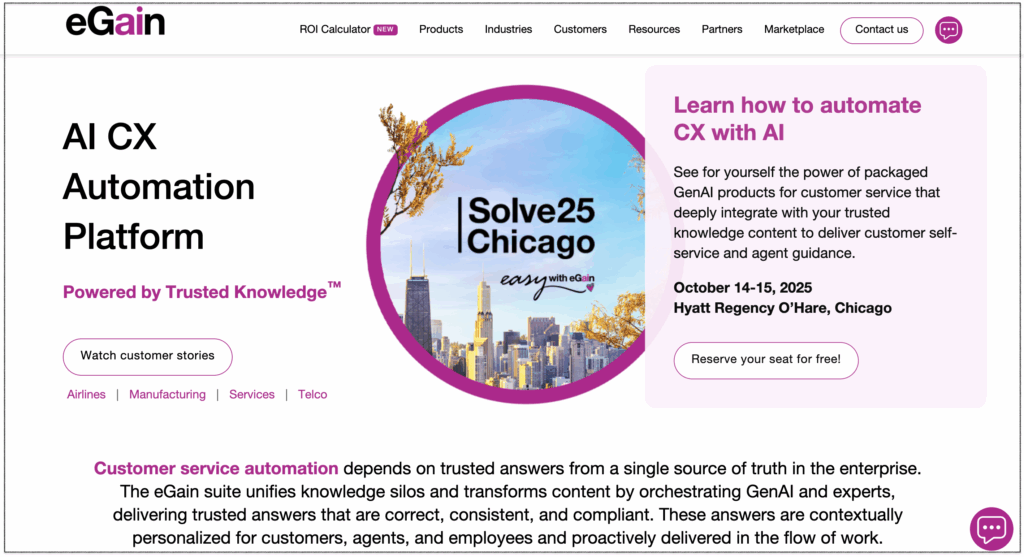
eGain is a long-standing knowledge management provider with a strong focus on customer service and contact center operations. It is known for its AI-powered knowledge hub, designed to help agents and customers quickly find accurate information. This makes it a formidable solution for large organizations where knowledge is intrinsically tied to complex, high-volume customer service workflows.
Who is eGain for?
For companies where the contact center is a central point of business, eGain provides a powerful, specialized platform to ensure knowledge consistency and operational efficiency. Its value proposition is built on making every agent as effective as the best one, primarily through its robust AI capabilities for guided assistance and omnichannel data delivery.
eGain Pros and Cons
eGain’s advanced search and discovery tools, along with its ability to integrate with existing enterprise systems such as CRM and ERP, create a single-pane-of-glass view of the customer. This provides agents with a comprehensive history and context for every interaction across various channels. By doing so, it offers personalized and efficient support, which directly impacts customer satisfaction.
On the other side of eGain’s power and complexity is a notable trade-off that affects its reputation. For instance, the platform is not an out-of-the-box solution. It has a steep learning curve and requires significant effort for optimal setup.
Furthermore, some users have reported performance issues, such as sluggishness and lag, which can be detrimental in a fast-paced contact center environment where every second counts. While the platform is ultimately powerful and effective once fully configured, the initial investment in time, resources, and training can be a point of friction, and its occasional performance issues can detract from an otherwise seamless agent experience.
eGain Pricing
eGain does not offer transparent pricing plans, as it is an enterprise-focused solution. Instead, it requires potential customers to contact them directly for a customized quote based on their specific needs. Pricing is typically modular and varies depending on the products and features an organization requires, such as the knowledge hub, omnichannel engagement tools, or AI assistants.
Expert Insights on eGain Features
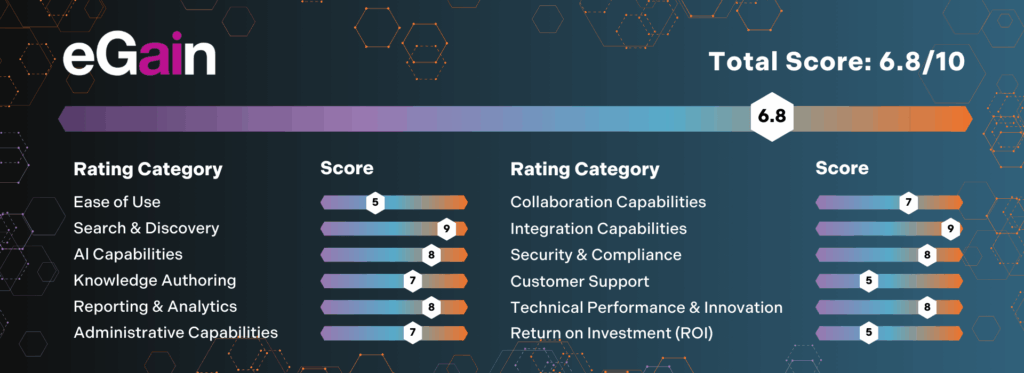
eGain’s Knowledge Hub provides real-time, guided knowledge to agents during conversations and its unified, composable platform. It also features extensive integration capabilities, enabling it to serve as a central hub within a broader customer engagement ecosystem, seamlessly connecting with key CRM and ERP systems.
Key features of eGain:
- Omnichannel engagement: Manages and automates customer interactions across a wide range of channels, including email, chat, social media, and voice
- Guided assistance and self-service: Tools that use AI and knowledge to guide agents through complex processes and enable customers to resolve their own issues
- Robust analytics and reporting: Comprehensive dashboards and reports to measure the effectiveness of the knowledge base, agent performance, and customer engagement
- Integrations with other systems: Integrates with existing CRM, contact center, and content systems to consolidate information and provide a single source of truth
While eGain provides an intuitive, user-friendly experience for agents and customers, its administrative and content creation backend can be complex and challenging. This contrast highlights a potential gap for managers who need a platform that is easy for everyone to contribute to and manage.
Bloomfire is often viewed as a superior alternative and one of the best knowledge management platforms for managers. It fosters a more collaborative, bottom-up approach to knowledge sharing. As a result, it empowers the entire organization to engage with and contribute to knowledge without the steep administrative learning curve found in eGain.
Bonus–Obsidian: Best Personal KM Solution
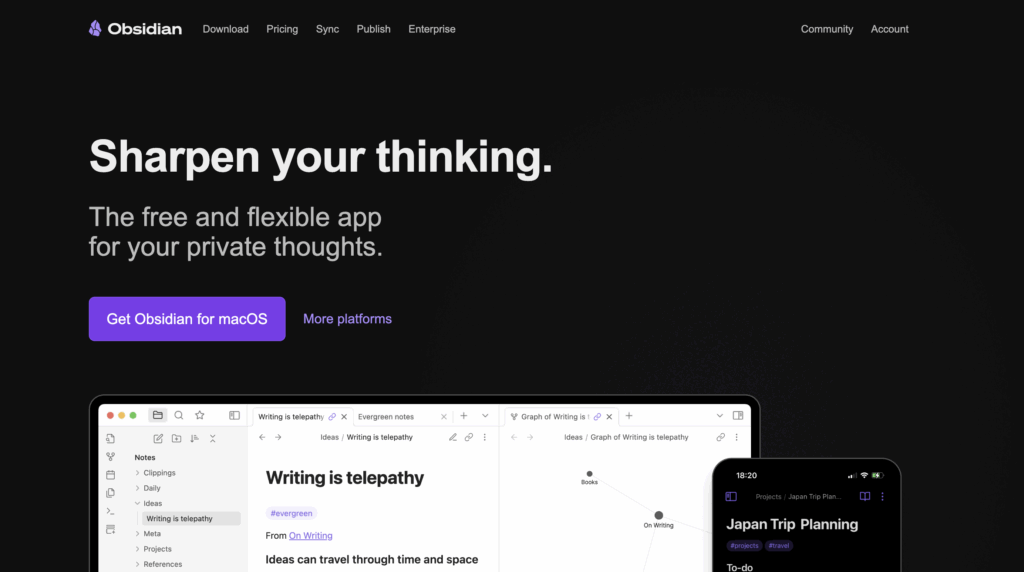
Obsidian is a knowledge management software provider known as a premier solution for personal knowledge management (PKM). Unlike traditional enterprise platforms, its defining characteristic is a local-first approach, storing all user data as plain-text Markdown files on their local machines, which gives users complete control and ownership over their information.
Who is Obsidian for?
Obsidian is the preeminent solution for individuals who need to build a robust, private, and highly personalized system for managing their knowledge. It is not an enterprise tool but a powerful application for a single user, such as a researcher, writer, or professional who needs to synthesize complex information from various sources.
Obsidian Pros and Cons
Obsidian nests on a foundation of local files, meaning notes are saved in plain text on the user’s device. This local-first philosophy is a central selling point, as it ensures privacy and data ownership, a significant advantage over cloud-based alternatives like Notion or Evernote.
Furthermore, the free-to-use core application, coupled with its highly flexible and customizable nature, allows individuals to tailor the app to their exact workflow. You can turn a simple note-taking tool into a personal wiki, a writing app for long-form projects, or a project management system.
However, the application’s most significant drawbacks are also linked to its renowned features. The reliance on Markdown* can be a major barrier for users unfamiliar with it. While the core app is free, essential features such as official, reliable, and encrypted cross-device syncing are available as a paid add-on. This pricing model is transparent, but can be a point of friction for users who expect seamless syncing as a standard feature, forcing them to either pay for the service or rely on more complex, third-party workarounds.
* Markdown is a lightweight markup language that allows you to add formatting elements to plain text using simple, intuitive syntax.
Obsidian Pricing
Obsidian operates on a freemium model with a modular pricing structure. The core application is free for personal use, forever, and includes all its powerful features, such as local file storage, community plugins, and themes. Users only pay for additional services and licenses, which are optional.
- Free: Core application for personal use
- Obsidian Sync: Starts at $4 per month (billed annually) for cross-device, encrypted syncing
- Obsidian Publish: Starts at $8 per month (billed annually) to publish notes to a public website
The two main paid services are Obsidian Sync, which provides end-to-end encrypted cloud syncing across devices, and Obsidian Publish, which allows users to publish their notes to a website. Both services offer a tiered pricing structure based on the number of vaults, storage, and other factors. There are also one-time payments for a Catalyst license to support the developers or a Commercial license for business use.
Expert Insights on Obsidian Features
Obsidian stands as the preeminent personal knowledge management tool. Its core strength lies in its local-first, plain-text file system, which gives users complete ownership and long-term control of their data.
Its powerful bi-directional linking and stunning Graph View are transformative features that foster non-linear connected thinking. It helps users discover new insights and connections between their ideas that would otherwise remain hidden in a traditional folder structure.
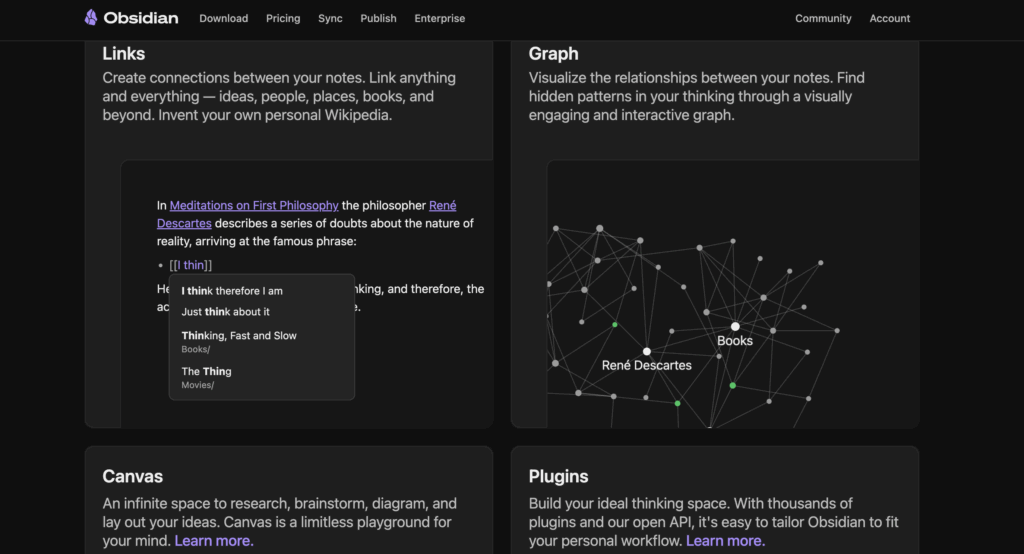
The highly extensible nature of the platform, powered by a vast community of developers who have created thousands of plugins, allows us to tailor the tool precisely to your unique workflow, from advanced task management to academic research and visual brainstorming with the Canvas feature.
Although promising in the personal KM solution front, some users experience a learning curve, while others prefer a more out-of-the-box experience. The consensus is that the initial investment in customization pays off with a flexible, responsive, and privacy-focused second brain that adapts to the user’s mind.
How We Evaluated the Top Knowledge Management Tools
We evaluated knowledge management products based on a comprehensive set of 12 criteria, each with a specific rationale and importance level, but with a consistent 10-point rating reference. This methodology was designed to move beyond a simple feature-by-feature comparison and assess how each solution contributes to a successful and sustainable knowledge management initiative within an organization.
We began by focusing on the user experience, giving Ease of Use and Search & Discovery a high and critical importance, respectively. We also heavily weighted AI Capabilities and Integration Capabilities because modern KM systems must be dynamic and seamlessly integrate with other business tools to avoid knowledge silos and actively assist users.
Our evaluation also looked at the administrative and strategic aspects of each platform. Security & Compliance was rated as a critical factor, as protecting an organization’s intellectual property and sensitive data is non-negotiable. Administrative Capabilities and Knowledge Authoring were given high importance because a knowledge base requires constant, effective management to remain accurate and relevant.
We also considered Collaboration, Reporting & Analytics, Customer Support, Technical Performance, and Return on Investment, all of which were crucial for understanding the long-term value and viability of each solution.
Our goal was to provide a holistic and actionable review to help buyers select a solution that not only meets their immediate needs but also encourages a culture of knowledge sharing and provides a measurable return on investment for their entire organization. Ultimately, when choosing the best knowledge management software for your organization, assess the criteria based on priority and your KM goals.
The Best Knowledge Management Solution For You
Finding the right knowledge management software isn’t about simply choosing a place to store files—it’s about selecting a dynamic platform that makes knowledge work for you. It should empower every team member to contribute, collaborate, and discover information precisely when and where they need it.
For enterprise organizations, Bloomfire remains at the top of the list for best knowledge management software solutions due to its robust set of tools that not only preserve knowledge but also continually update and make it ready for use. But for its capabilities to turn knowledge into actionable intelligence that drives productivity, innovation, and efficiency.
Supercharge Your KM Program!
Learn how Bloomfire can fuel your knowledge to raise your bottom line.
Book a Demo

Digitalization and Digitization of Business Processes (+How They Drive Digital Transformation)

What Is Business Digitization? A Comprehensive Guide to Modernizing Your Operations

How Proactive Business Leaders Are Preserving Their People’s Knowledge

Start working smarter with Bloomfire
See how Bloomfire helps companies find information, create insights, and maximize value of their most important knowledge.

Take a self guided Tour
See Bloomfire in action across several potential configurations. Imagine the potential of your team when they stop searching and start finding critical knowledge.